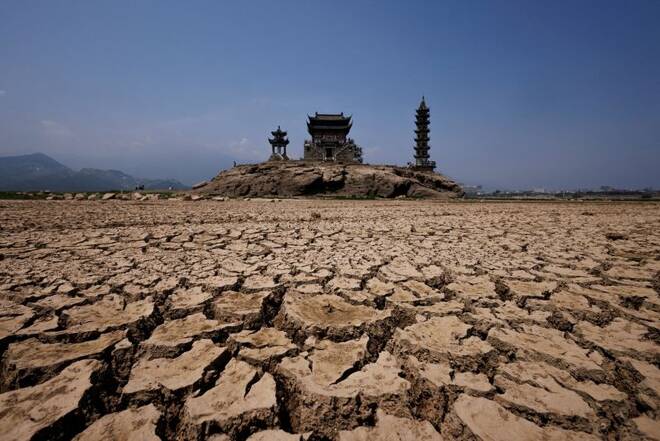Advertisement
Advertisement
Explainer-The power crunch in China’s Sichuan and why it matters
By:
(Reuters) - The southwestern province of Sichuan, China's biggest hydropower producer, has seen its supply capability slump due to a long drought across the Yangtze basin, stoking fears the country could suffer another devastating power shortage.
(Reuters) – The southwestern province of Sichuan, China’s biggest hydropower producer, has seen its supply capability slump due to a long drought across the Yangtze basin, stoking fears the country could suffer another devastating power shortage.
Sichuan’s accounts for 30% of China’s total hydroelectric generation and it normally delivers a massive power surplus to the rest of the country. But it is now receiving electricity from other provinces after weeks of minimal rainfall and extreme temperatures in excess of 40 Celsius (104 Fahrenheit).
Here is what you need to know about the power crunch.
Why is sichuan suffering power shortages?
Hydropower is the biggest source of electricity supply in Sichuan, accounting for more than 80% of total power production.
May to October is typically Sichuan’s rainy season, allowing hydropower stations to maximise output to meet peak summer demand.
However, rainfall fell 30% in July and 60% in August compared to the seasonal average, severely curtailing hydropower generation capacity.
Though Sichuan has abundant coal stocks, coal-fired power makes up just 16% of its total power capacity, not enough to meet the supply-demand gap.
The peak power load in Sichuan also surged 25% from a year ago because of high air conditioner use. Meanwhile, consumption from industrial users has also risen in recent years with high-energy intensive industries including aluminium and silicon moving to the region to take advantage of cheaper energy costs.
Sichuan typically exports nearly a third of the electricity it generates via ultra-high voltage (UHV) transmission lines to eastern coastal regions such as Shanghai, Zhejiang and Jiangsu.
Despite local shortages, Sichuan stills needs to fulfil part if not all of its cross-provincial power transmission contracts, which the grid usually treats as a priority.
What was the impact on companies?
Industrial plants in a wide variety of sectors in Sichuan and neighbouring Chongqing – including well-known names like Taiwan’s Foxconn and battery giant CATL – have been ordered to shut down or curb output since mid-August to conserve power for household users.
More than a dozen listed firms have warned that rationing could cause severe delays to cargo delivery and cause billions of yuan of losses.
The rolling blackout eventually hit residential users as the power shortage worsened. Commercial venues were also asked to cut working hours to save electricity.
How wide is the impact and how long will it last?
Several regions in central and eastern China have also warned of tight power supply and have introduced power rationing to industrial users.
But analysts say the power crunch this year will be less severe than the one from last September and October, when high coal prices and supply shortages hit more than 27 provinces and regions. Regional power rationing is expected to ease in September and October when temperatures fall.
Power utilities have boosted output and grid firms are dispatching electricity from northeastern and northwestern regions to Sichuan and eastern China. The State Grid Corporation said on Wednesday it was delivering 130 million kilowatt-hours of power per day to Sichuan.
However, analysts also warned the risk of power shortages is still high in the coming winter when the power load spikes again, driven by heating needs.
What does it mean for national power system?
China’s National Energy Administration (NEA) has started to adjust its power development plans over 2021-2025 in response to the power shortages. The authority will accelerate the construction of new hydropower stations as well as the approval of nuclear plants and power transmission projects.
China’s leading power-exporting regions, including Yunnan and Guizhou as well as Sichuan, mainly source their electricity from hydropower, which is becoming more volatile as a result of climate change.
Sichuan’s provincial grid-connected utilities have already cut power exports by 10% in 2021 compared to a year earlier, though the state-level grid-linked power plants maintained the same level of transmission.
More grid flexibility is also required, with China trying to develop a power market to help provinces respond more quickly to changes in supply and demand. Experts say bigger and smarter grids should be a priority.
Fast growing renewables also require the grid to invest more in power storage and upgrade its system to accommodate the intermittency of solar and wind power.
Meanwhile, coal is still expected to play a pivotal role, making it more difficult for China to phase the fossil fuel out of its energy system and meet its low-carbon goals.
(Reporting by Muyu Xu in Singapore and David Stanway in Shanghai; Editing by Lincoln Feast.)
About the Author
Reuterscontributor
Reuters, the news and media division of Thomson Reuters, is the world’s largest international multimedia news provider reaching more than one billion people every day. Reuters provides trusted business, financial, national, and international news to professionals via Thomson Reuters desktops, the world's media organizations, and directly to consumers at Reuters.com and via Reuters TV. Learn more about Thomson Reuters products:
Advertisement
